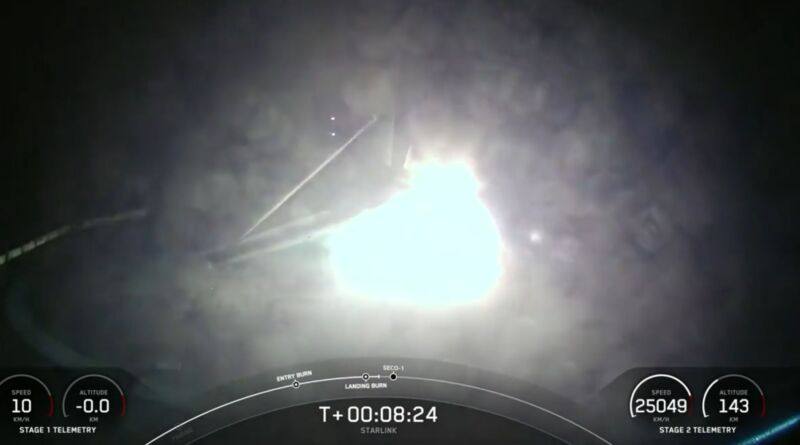
SpaceX
Early on Wednesday morning, at 3:48 am ET local time, a Falcon 9 rocket booster making its 23rd launch took off from Space Launch Complex-40 at Cape Canaveral, Florida.
The mission successfully delivered 21 Starlink satellites, including 13 of the larger vehicles with direct-to-cell capabilities, before attempting a landing on the A Shortfall of Gravitas. However, the experienced booster had a shortfall of stability and tipped over shortly following touchdown.
Prior to Wednesday’s landing failure, SpaceX had landed 267 boosters in a row. The company’s last failure occurred in February 2021. The cause of the failure was not immediately clear, and SpaceX said “teams are assessing the booster’s flight data and status.” Based on video of the landing, it is possible there was an engine burn timing issue.
Fleet leader
This particular first stage of the Falcon 9 rocket made its debut in November 2020, launching the GPS III-04 mission for the US Space Force. By making its 23rd launch on Wednesday morning, Booster 1062 briefly became the fleet leader of SpaceX’s collection of first stages that perform a majority of the company’s launches.
Booster landings are considered secondary objectives to a launch’s primary mission of delivering payloads into orbit. However, in recent years SpaceX has delayed launches due to poor recovery weather conditions, as it does not want to lose the first-stage hardware, which probably costs at least $20 to $30 million to manufacture, test, and deliver to the launch site.
The landing failure had one immediate consequence for the company’s launch manifest. A second Starlink launch planned for early Wednesday morning, from the other side of the country at Vandenberg Space Force Base, was scrubbed so that SpaceX could assess the cause of the landing issue with the Florida launch.
Implications for Polaris Dawn
It is not clear whether the landing problem will impact the high-profile Falcon 9 launch of the Polaris Dawn mission, carrying Jared Isaacman and three other pilots and engineers on an adventurous mission to an orbit more than 1,200 km above the Earth before performing the first private spacewalk.
A planned launch of this mission on early Tuesday morning was scrubbed after a helium leak was discovered in the ground systems that support the rocket. Then, a second launch attempt of the vehicle on early Wednesday was scrubbed several hours before liftoff due to weather issues. Meteorologists are concerned about sea states for the Crew Dragon vehicle’s landing three to five days after liftoff, when the spacecraft returns to Earth in the seas near Florida.
“Our launch criteria are heavily constrained by forecasted splashdown weather conditions,” Isaacman wrote on X on Tuesday evening. “With no ISS rendezvous and limited life support consumables, we must be absolutely sure of reentry weather before launching. As of now, conditions are not favorable tonight or tomorrow, so we’ll assess day by day.”
The earliest that the Polaris Dawn mission could launch is now Friday morning, at 3:38 am ET (07:38 UTC) from Kennedy Space Center, in Florida. But that is dependent on both weather and, now, SpaceX becoming comfortable with understanding the landing failure of Wednesday morning’s Starlink launch.




















+ There are no comments
Add yours